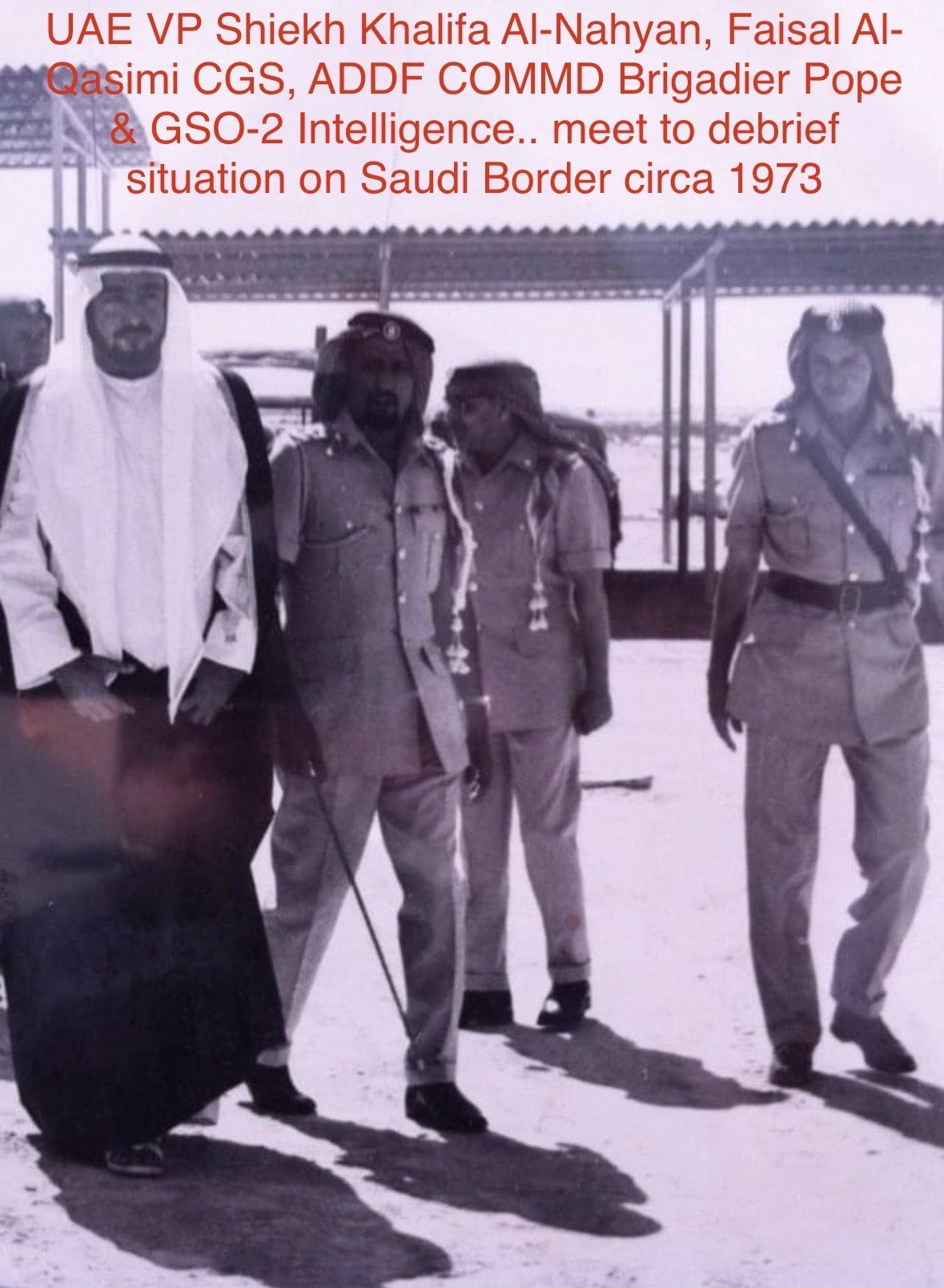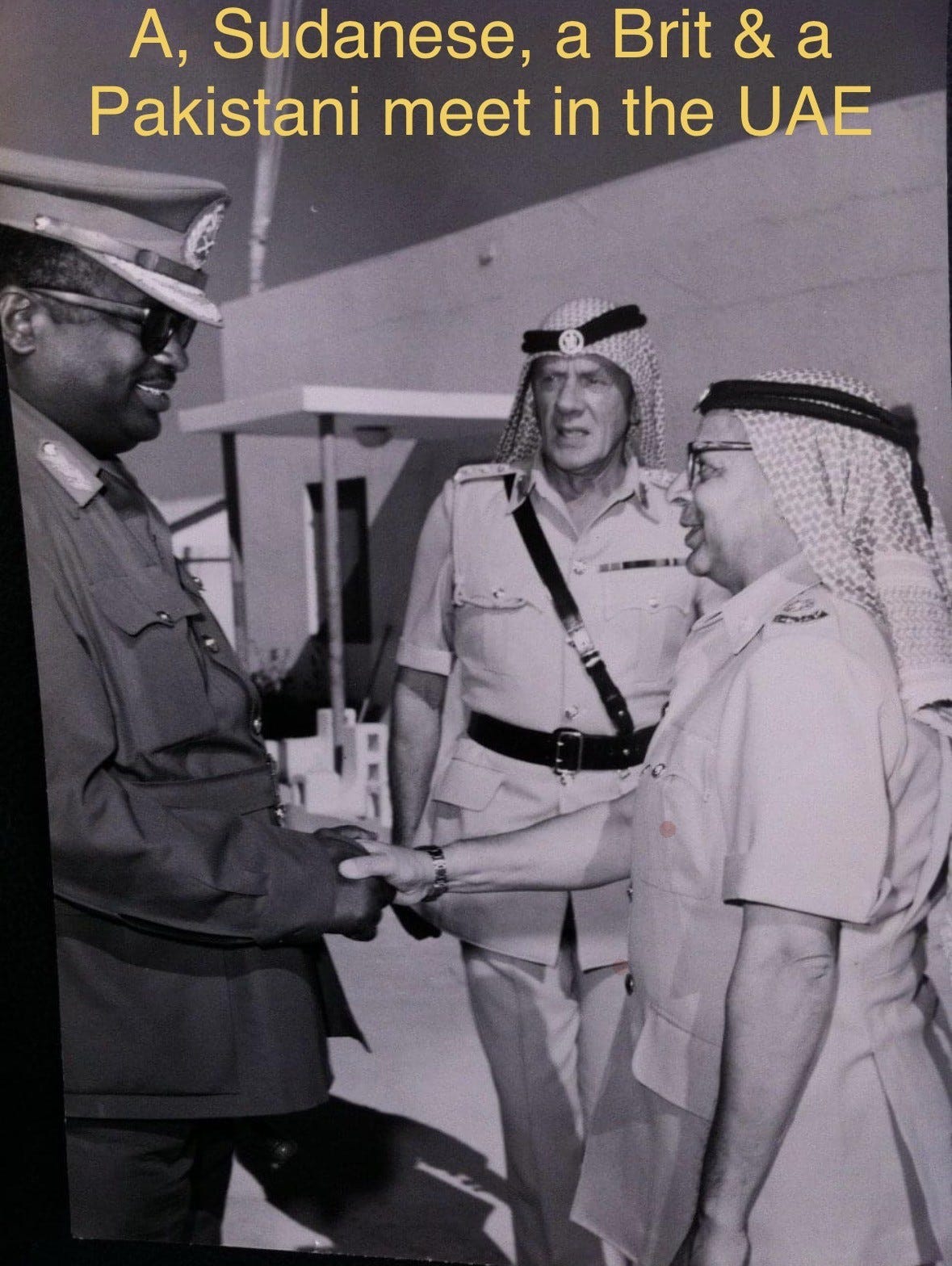From Vacuum to Vanguard: The UAE's Evolving Grip on Gulf and Red Sea Geopolitics
Birth in the Breach: Zayed's Federation Amid Imperial Retreat
The United Arab Emirates (UAE) emerged in 1971 not as a romantic union of desert sheikhdoms, but as a calculated bulwark against the power vacuum left by Britain’s hasty exit from the Persian Gulf. London’s 1968 announcement of withdrawal - finalized by 1971 - shattered the protective umbrella over the Trucial States, inviting predators into a region awash in oil and ambition. For the Al Nahyan family, survival had long been the overriding imperative. Sheikh Zayed bin Sultan Al Nahyan, Abu Dhabi’s ruler since 1966, had ascended under the shadow of violence: in 1926, his father, Sultan bin Zayed, was assassinated in a palace coup by his brother Saqr, who was in turn killed two years later by another brother, Shakhbut. This fratricidal cycle - exploited by British political agents to install compliant rulers - left Zayed acutely aware of the family’s precarious perch within the imperial chessboard. The Al-Nahyan’s were never sovereign in the absolute sense; they were tolerated proxies, their legitimacy underwritten by British bayonets. Zayed’s 1966 coup against Shakhbut - backed by British intelligence and executed bloodlessly- was the final act in this dynastic drama, positioning him to orchestrate federation as both shield and sword. Oil strikes in Abu Dhabi from 1958 onward flooded its coffers, but Zayed knew wealth alone could not secure survival; only unity could.
Negotiations, fraught with tribal rivalries and revenue disputes, culminated on December 2, 1971, when six emirates - Abu Dhabi, Dubai, Sharjah, Ajman, Umm al-Quwain, and Fujairah - declared independence, with Ras al-Khaimah joining in 1972. Zayed, elected president, fused fragile fiefdoms into a federation that filled the British void, deterring Iranian irredentism and Saudi encroachments while diluting pan-Arab radicalism. His grand strategy was rooted in realism: neutralize internal threats from Abu Dhabi’s fractious tribes, like the Hamdan clan’s claims to inland loyalties, through economic largesse. The Trucial States Development Fund, pre-federation, poured petrodollars into cross-emirate infrastructure - schools, ports, roads - binding potential rebels in prosperity’s web. “Money is of no value unless it is used for the benefit of the people,” Zayed quipped, but the subtext was clear: co-opt or conquer.
Externally, threats loomed larger. Shah Mohammad Reza Pahlavi’s imperial Iran seized Abu Musa and the Tunbs islands from Sharjah in November 1971, a prelude to Gulf dominance. Pan-Arab militarists - Nasser’s Egypt (until 1970), Assad’s Syria, Hussein’s Jordan, Gaddafi’s Libya - branded Gulf royals as imperial puppets, while Palestinian fedayeen refugees, radicalized by 1948 and 1967 defeats, menaced from Jordan’s Black September chaos. Zayed’s antidote? “Keep your enemies close” via monetary incentives. Abu Dhabi’s billions bankrolled Arab League causes, Palestinian aid, and Egyptian modernization, forging interdependence. By 1975, UAE grants and loans exceeded AED 98 billion, casting it as the Gulf’s financier, a velvet glove over an iron fist. This soft power stabilized the federation, birthed the GCC in 1981, and reshaped Gulf geopolitics, turning vulnerability into veiled hegemony.
Forged in the Sands: The Evolution of UAE Military Might
Central to Zayed’s vision was a nascent military apparatus, rapidly professionalized to underpin the federation’s sovereignty. The UAE Armed Forces trace their roots to the British-led Trucial Oman Scouts, established in 1951 as the Trucial Oman Levies to maintain order along the Gulf coast. Renamed in 1956, this mobile force of about 1,600 men - commanded by British officers and assisted by Jordanian NCOs - symbolized imperial stability, quelling tribal disputes and curbing smuggling. Upon Britain’s 1971 withdrawal, the Scouts were transferred to the UAE as the core of its defense structure, forming the Union Defense Force (UDF) and absorbing into emirate-specific units like the Abu Dhabi Defense Force (ADDF), established in 1965 under Sheikh Shakhbut Al-Nahyan and initially commanded by British Major Edward ‘Tug’ Wilson.
The ADDF’s early ranks drew eclectic expertise: British military and intelligence advisors provided command and training, Sudanese personnel contributed desert warfare savvy from their own arid campaigns, and Pakistani officers - leveraging 1970s defense protocols - imparted technical skills in aviation and logistics. Jordan supplied noncommissioned officers and, notably, Army Medical Corps (AMC) personnel for field medicine, alongside Pakistani medics to bolster health support in remote outposts. This multinational infusion, blending Western discipline with Arab and South Asian pragmatism, enabled rapid scaling: by 1972, the ADDF Air Wing boasted Hunter jets, while the UDF unified forces from Abu Dhabi, Dubai, and Ras al-Khaimah into the Yarmouk Brigade. In 1974, at the military mess in Abu Dhabi, a young Captain Mohamed bin Zayed (MBZ) - then a cadet fresh from Sandhurst - was introduced to foreign advisors, including military intelligence officers serving under Brigadier David Pope, the British Commander of ADDF. To one observer, MBZ seemed unassuming, almost shy: down-to-earth, asking sharp questions about radar systems and desert logistics. The pragmatism that would later define his rule was already forming, but so was the irony - on that same day, Pope introduced the Sudanese army chief (whose forces would, decades later, clash with UAE-backed militias in Darfur and Khartoum, see picture circa-1974). By 1976, these disparate elements coalesced into the modern UAE Armed Forces under a federal General Headquarters in Abu Dhabi, complete with standardized insignia, academies, and branches for army, air force, and navy.
Today, this force - nicknamed “Little Sparta” by U.S. generals - projects power across chokepoints, with airstrips on far-flung islands like Yemen’s Socotra (seized in 2018), Perim in the Bab al-Mandeb Strait (base built 2021), and the newly constructed Zuqar runway (2025) enabling surveillance and rapid strikes over the Red Sea and Gulf of Aden. Augmented by mercenaries - Colombian and Australian contractors via Erik Prince’s 2011 initiative, plus U.S. veterans in advisory roles - the UAE’s 65,000-strong military (with reserves and auxiliaries pushing totals higher) wields F-35s, THAAD systems, and drone swarms, transforming Zayed’s defensive nucleus into MBZ’s expeditionary vanguard.
Overstretch Echoes: MBZ’s Kinetic Calculus in a Multipolar Maze
By November 2025, the Gulf confronts a déjà vu: America’s overextension - tied down in Ukraine, pivoting to Asia, and riven domestically - mirrors Britain’s 1971 fatigue. With 40,000–50,000 troops across bases like Qatar’s Al Udeid, U.S. deterrence frays against Iranian missiles, Houthi Red Sea barrages, and Syrian proxies. Gulf states hedge: China inks Belt and Road ports, Russia swaps energy, and the 2023 Saudi-Iran détente (brokered by Beijing) underscores multipolarity. Trump’s May 2025 Gulf tour - arms deals in Riyadh, Doha, Abu Dhabi - masked this drift, as UAE sovereign funds balloon to $1.7 trillion, fueling non-oil GDP to 70%.
Under Sheikh Mohamed bin Zayed Al Nahyan (MBZ), Zayed’s youngest son and UAE president since 2022, the federation has morphed from unifier to regional architect. The transition - from Zayed (d. 2004) and successor Khalifa (d. 2022, post-2014 stroke elevating MBZ) - heralded a generational shift. Where Zayed wielded checkbooks, MBZ deploys drones and leverage: Yemen interventions (2015–2019), Libya backing for Haftar, Sudan RSF arming, Somali port stakes. This “muscular pragmatism” - kinetic actions fused with economic coercion - secures chokepoints like Hormuz (via UAE-Oman southern flank) and Red Sea (49% Sudanese ports, Yemeni islands at Bab al-Mandab, DP World logistics). Yet, it breeds backlash: Sudanese genocide accusations at the ICJ (May 2025), Somali secessionist fears in Jubaland, Yemeni Houthi resilience, Pakistani unease over UAE-Pakistan military pacts amid economic bailouts.
Internal tribal tensions, once Zayed’s bugbear, appear largely dormant. The Hamdan family - prominent Bedouins in Abu Dhabi’s hinterlands - now integrates via marriages (MBZ wed Sheikha Salama bint Hamdan) and roles (Sheikh Hamdan bin Zayed chairs environment agencies). No major unrest since mid-2000s marginalization of Bani Fatima rivals; cosmopolitan Abu Dhabi, with expat majorities, supplants tribal fissures. Yet, whispers persist: opaque sidelinings in executive councils, and broader Bani Yas clan dynamics under MBZ’s nephews (e.g., Tahnoon bin Zayed’s financial empire facing intra-family competition).
The international community treads warily on MBZ’s tactics. U.S. support is tacit but robust; CENTCOM greenlights UAE “dirty work” for Hormuz-Red Sea stability, where UAE stakes (Fujairah pipeline bypassing Hormuz, Berbera base) counter Iran. Biden’s 2024 Major Defense Partner designation, Trump’s $200 billion AI deals (May 2025), and F-35 talks affirm this: Abu Dhabi as Washington’s proxy, sans full scrutiny. Europe echoes: UK engines in UAE Nimr vehicles fuel RSF atrocities, per UN dossiers (2024–2025), yet arms flow. UN sanctions loom - UAE denies RSF arms via Libya/Chad - but enforcement falters; Saudi mediation in Jeddah (2023–2025) yields ceasefires, not accountability. Apprehension mounts in targets: Sudan expels UAE envoys (2025), Somalia protests Jubaland meddling, Yemen’s STC fractures Saudi unity. Still, global inertia - 25 million Sudanese in famine (IPC 2025) - lets UAE persist, blending aid ($750 million Syrian refugees) with coercion.
The UAE’s Russian dalliance puzzles: a 2023 “strategic partnership” deepens, BRICS entry (2024), trade doubling to $11.5 billion (2024). Putin-MBZ summits (2023–2025) yield prisoner swaps, nuclear tech. Convergence? Libya/Sudan: UAE-Haftar-Wagner/RSF gold smuggling, arms via Al-Khadim base (Russian-UAE ops since 2016). Moscow eyes Port Sudan naval base (2025 deal post-Syria Assad fall), UAE logistics enable. Washington? A “wait-and-see” game: sanctions pressure (UAE “focus” 2023 for Russia evasion), yet overlooks for shared anti-Islamist gains; UAE airstrikes on Somali al-Shabaab (2023), Russian Wagner in Sahel. U.S. frustration (Rubio accuses UAE genocide-enabling, 2025) clashes with pragmatism: UAE hedges China/Russia to extract F-35s, AI chips. As one analyst notes, “Abu Dhabi plays independents, Washington plays enabler.”
In 2025, the UAE - $500 billion economy, Barakah nuclear online, Mars probes - dictates Gulf-Red Sea destiny. Zayed’s incentives evolved into MBZ’s hybrid warfare, filling U.S. voids while testing alliances. Liquidity remains power but now laced with drones: a federation that doesn’t just survive vacuums - it engineers them.





